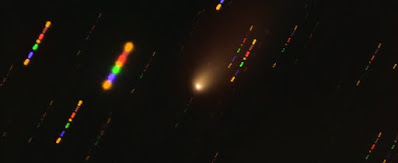2I/Borisov was discovered by amateur astronomer Gennady Borisov in August 2019 and was confirmed to have come from beyond the Solar System a few weeks later. “2I/Borisov could represent the first truly pristine comet ever observed,” says Stefano Bagnulo of the Armagh Observatory and Planetarium, Northern Ireland, UK, who led the new study published today in Nature Communications. The team believes that the comet had never passed close to any star before it flew by the Sun in 2019.
Bagnulo and his colleagues used the FORS2 instrument on ESO's VLT, located in northern Chile, to study 2I/Borisov in detail using a technique called polarimetry [1]. Since this technique is regularly used to study comets and other small bodies of our Solar System, this allowed the team to compare the interstellar visitor with our local comets.
The team found that 2I/Borisov has polarimetric properties distinct from those of Solar System comets, with the exception of Hale–Bopp. Comet Hale–Bopp received much public interest in the late 1990s as a result of being easily visible to the naked eye, and also because it was one of the most pristine comets astronomers had ever seen. Prior to its most recent passage, Hale–Bopp is thought to have passed by our Sun only once and had therefore barely been affected by solar wind and radiation. This means it was pristine, having a composition very similar to that of the cloud of gas and dust it — and the rest of the Solar System — formed from some 4.5 billion years ago.
By analysing the polarisation together with the colour of the comet to gather clues on its composition, the team concluded that 2I/Borisov is in fact even more pristine than Hale–Bopp. This means it carries untarnished signatures of the cloud of gas and dust it formed from.
“The fact that the two comets are remarkably similar suggests that the environment in which 2I/Borisov originated is not so different in composition from the environment in the early Solar System,” says Alberto Cellino, a co-author of the study, from the Astrophysical Observatory of Torino, National Institute for Astrophysics (INAF), Italy.
Olivier Hainaut, an astronomer at ESO in Germany who studies comets and other near-Earth objects but was not involved in this new study, agrees. “The main result — that 2I/Borisov is not like any other comet except Hale–Bopp — is very strong,” he says, adding that “it is very plausible they formed in very similar conditions.”
“The arrival of 2I/Borisov from interstellar space represented the first opportunity to study the composition of a comet from another planetary system and check if the material that comes from this comet is somehow different from our native variety,” explains Ludmilla Kolokolova, of the University of Maryland in the US, who was involved in the Nature Communications research.
Bagnulo hopes astronomers will have another, even better, opportunity to study a rogue comet in detail before the end of the decade. “ESA is planning to launch Comet Interceptor in 2029, which will have the capability of reaching another visiting interstellar object, if one on a suitable trajectory is discovered,” he says, referring to an upcoming mission by the European Space Agency.

